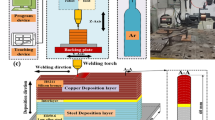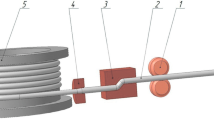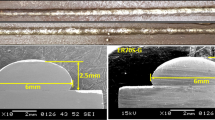Currently, there are few works devoted to the change in the microstructure of steel-copper bimetallic wire during its deformation. Since steel and copper have different mechanical properties, these metals can deform differently at the interface. Therefore, the present study was devoted to the investigation of the effect of the equal channel angular pressing drawing process on the properties of bimetallic steel- copper wire. Deformation was carried out at room temperature in three deformation passes. It is shown that good hardening of the bimetallic wire occurs already in three passes, the tensile strength of the steel- copper wire increases from 580 MPa in the initial state to 812 MPa after the third pass. The yield strength increases from 380 MPa in the initial state to 562 MPa after the third pass. At that, the main increase in strength occurs in the first two passes of deformation.




Similar content being viewed by others
References
H. Dyja, L. Lesik, A. Milenin, and S. Mroz, “Theoretical and experimental analysis of stress and temperature distributions during the process of rolling bimetallic rods,” J. Mater. Process. Tech., 125, 731–735 (2002).
I. E. Volokitina, A. B. Naizabekov, E. A. Panin, and A. V. Volokitin, “Effect of ECAP-drawing on the microstructure of a bimetallic wire,” Metallurgist, 65, No. 7-8, 769–774 (2021).
A. R. Eivani, H. R. Mirzakoochakshirazi, and H. R. Jafarian, “Investigation of joint interface and cracking mechanism of thick cladding of copper on aluminum by equal channel angular pressing (ECAP),” J. Mater. Res. Tech., 9, No. 3, 3394–3405 (2020).
L. Y. Sheng, F. Yang, T. F. Xi, et al., “Influence of heat treatment on interface of Cu/Al bimetal composite fabricated by cold rolling,” Compos. Part B Eng., 42, No. 6, 1468–1473 (2011).
A. I. Nayzabekov and I. E. Volokitina, “Effect of the initial structural state of Cr–Mo high-temperature steel on mechanical properties after equal-channel angular pressing,” Phys. Met. Metallogr., 120, No. 2, 177–183 (2019).
M. V. Chukin, A. G. Korchunov, E. M. Golubchik, et al., “Analysis of method of continuous deformation nanostructuring of wire using the concept of technological inheritance,” Vestn. MGTU Nosov., No. 4, 61–65 (2012).
A. P. Zhilyaev and T. G. Langdon, “Using high-pressure torsion for metal processing: Fundamentals and applications,” Prog. Mater. Sci., 53, No. 6, 893–979 (2008).
P. Eslami and A. K. Taheri, “An investigation on diffusion bonding of aluminum to copper using equal channel angular extrusion process,” Mater. Lett., 65, No. 12, 1862–1864 (2011).
M. Yu. Murashkin, I. Sabirov, V. U. Kazykhanov, et al., “Enhanced mechanical properties and electrical conductivity in ultrafinegrained Al alloy processed via ECAP-PC,” J. Mater. Sci., 48, 4501–4509 (2013).
A. Bachmaier, T. Grosdidier, and Yu. Ivanisenko, “Severe plastic deformation and thermomechanical processing: Nanostructuring and properties,” Metals, 10, No. 10, 1306 (2020).
I. S. Choi, R. Schwaiger, L. Kurmanaeva, and O. Kraft, “On the effect of Ag content on the deformation behavior of ultrafinegrained Pd–Ag alloys,” Scripta Mater., 61, No. 1, 64–67 (2009).
I. E. Volokitina and G. G. Kurapov, “Effect of initial structural state on formation of structure and mechanical properties of steels under ECAP,” Met. Sci. Heat Treat., 59, No. 11-12, 786–792 (2018).
Z. Horita, T. Fujinami, and T. G. Langdon, “The potential for scaling ECAP: Effect of sample size on grain refinement and mechanical properties,” Mater. Sci. Eng. A, 318, No. 1-2, 34–41 (2001).
B. Tolaminejad, A. K. Taheri, M. Shahmiri, and H. Arabi, “Development of crystallographic texture and grain refinement in the aluminum layer of Cu-Al-Cu tri-layer composite deformed by equal channel angular extrusion,” Int. J. Mod. Phys. Conf. Ser., 5, 325–334 (2012).
P. Eslami, A. K. Taheri, and M. Zebardast, “A comparison between cold-welded and diffusion-bonded Al/Cu bimetallic rods produced by ECAE process,” J. Mater. Eng. Perform., 22, 3014–3023 (2013).
G. J. Raab, R. Z. Valiev, T. C. Lowe, and Y. T. Zhu, “Continuous processing of ultrafine grained Al by ECAP-Conform,” Mater. Sci. Eng. A, 382, No. 1-2, 30–34 (2004).
V. M. Segal, “Engineering and commercialization of equal channel angular extrusion (ECAE),” Mater. Sci. Eng. A, 386, No. 1-2, 269–276 (2004).
G. V. Shimov, A. A. Bogatov, and D. S. Kovin, “FEM simulation of copper busbar pressing on the continuous extrusion line “Conform,” Solid State Phenomen., 284, 547–551 (2018).
A. Naizabekov, S. Lezhnev, E. Panin, et al., “The effect of preliminary and final heat treatment in course of the combined “rollingpressing” process realization on microstructure evolution of copper,” J. Chem. Technol. Metall., 51, 315–321 (2016).
A. V. Zinov’ev, A. N. Koshmin, and A. Ya. Chasnikov, “Influence of the parameters of the continuous pressing process on the formation of the microstructure and mechanical properties of round-section rods from M1 alloy,” Metallurg, No. 4, 94–98 (2019).
M. Polyakova, A. Gulin, and D. Konstantinov, “Investigation of microstructure and mechanical properties of carbon steel wire after continuous method of deformational nanostructuring,” Appl. Mechan. Mater., 436, 114–120 (2013).
K. Muszka, M. Wielgus, K. Doniec, and M. Stefanska-Kadziela, “Influence of strain path changes on microstructure inhomogeneity and mechanical behavior of wire drawing products,” Mater. Sci. Forum, 654, 314–317 (2010).
Russian Federation Patent 2446937, IPC B21C1/00, Method for Producing Long Billets of Round Cross Section with an Ultrafine-Grained Structure [in Russian], claimed by M. V. Chukin, D. G. Emaleeva, M. P. Baryshnikov, and M. A. Polyakova, No. 2010122149 (2012).
Russian Federation Patent 2446937/02, IPC B21C1/00, Method for Producing Ultrafine-Grained Semi-Finished Products by Drawing with Torsion [in Russian], claimed by M. V. Chukin, M. A. Polyakova, E. M. Golubchik, et al., No. 2011107637 (2012).
Russian Federation Patent 2347632, IPC B21C1/00, Device for Drawing and Producing Ultrafine-Grained Semi-Finished Products [in Russian], claimed by G. I. Raab and A. G. Raab, No. 2007141898 (2009).
M. V. Chukin and D. G. Emaleeva, “Influence of heat treatment on the evolution of the structure and properties of steel wire during ECAP drawing,” Vestn. MGTU Nosov., No. 2, 70–74 (2008).
I. E. Volokitina and A. V. Volokitin, “Evolution of the microstructure and mechanical properties of copper during the pressingdrawing process,” Phys. Met. Metallogr., 119, 917–921 (2018).
I. E. Volokitina, A. V. Volokitin, A. B. Naizabekov, and S. N. Lezhnev, “Change in structure and mechanical properties of grade A0 aluminum during implementation of a combined method of ECAE-drawing deformation,” Metallurgist, 63, No. 9-10, 978–983 (2020).
S. N. Lezhnev, I. E. Volokitina, and A. V. Volokitin, “Evolution of microstructure and mechanical properties of steel in the course of pressing-drawing,” Phys. Met. Metallogr., 118, 1167–1170 (2017).
Author information
Authors and Affiliations
Corresponding author
Additional information
Translated from Metallurg, Vol. 67, No. 2, pp. 93–99, February, 2023. Russian DOI:https://doi.org/10.52351/00260827_2023_02_93.
Rights and permissions
Springer Nature or its licensor (e.g. a society or other partner) holds exclusive rights to this article under a publishing agreement with the author(s) or other rightsholder(s); author self-archiving of the accepted manuscript version of this article is solely governed by the terms of such publishing agreement and applicable law.
About this article
Cite this article
Volokitina, I.E., Volokitin, A.V. Changes in Microstructure and Mechanical Properties of Steel-Copper Wire During Deformation. Metallurgist 67, 232–239 (2023). https://doi.org/10.1007/s11015-023-01510-7
Received:
Revised:
Accepted:
Published:
Issue Date:
DOI: https://doi.org/10.1007/s11015-023-01510-7




